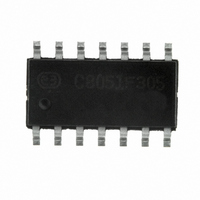C8051F305-GS Silicon Laboratories Inc, C8051F305-GS Datasheet - Page 80

C8051F305-GS
Manufacturer Part Number
C8051F305-GS
Description
IC 8051 MCU 2K FLASH 14-SOIC
Manufacturer
Silicon Laboratories Inc
Series
C8051F30xr
Specifications of C8051F305-GS
Program Memory Type
FLASH
Program Memory Size
2KB (2K x 8)
Package / Case
14-SOIC (3.9mm Width), 14-SOL
Core Processor
8051
Core Size
8-Bit
Speed
25MHz
Connectivity
SMBus (2-Wire/I²C), UART/USART
Peripherals
POR, PWM, WDT
Number Of I /o
8
Ram Size
256 x 8
Voltage - Supply (vcc/vdd)
2.7 V ~ 3.6 V
Oscillator Type
External
Operating Temperature
-40°C ~ 85°C
Processor Series
C8051F3x
Core
8051
Data Bus Width
8 bit
Data Ram Size
256 B
Interface Type
I2C/SMBus/UART
Maximum Clock Frequency
25 MHz
Number Of Programmable I/os
8
Number Of Timers
3
Maximum Operating Temperature
+ 85 C
Mounting Style
SMD/SMT
3rd Party Development Tools
PK51, CA51, A51, ULINK2
Development Tools By Supplier
C8051F300DK
Minimum Operating Temperature
- 40 C
Lead Free Status / RoHS Status
Lead free / RoHS Compliant
For Use With
770-1006 - ISP 4PORT FOR SILABS C8051F MCU336-1444 - ADAPTER PROGRAM TOOLSTICK F300
Eeprom Size
-
Data Converters
-
Lead Free Status / Rohs Status
Lead free / RoHS Compliant
Other names
336-1540-5
C8051F300/1/2/3/4/5
8.4.
The CIP-51 core has two software programmable power management modes: Idle and Stop. Idle mode
halts the CPU while leaving the peripherals and clocks active. In Stop mode, the CPU is halted, all inter-
rupts and timers (except the Missing Clock Detector) are inactive, and the system clock is stopped (analog
peripherals remain in their selected states). Since clocks are running in Idle mode, power consumption is
dependent upon the system clock frequency and the number of peripherals left in active mode before
entering Idle. Stop mode consumes the least power. SFR Definition 8.12 describes the Power Control Reg-
ister (PCON) used to control the CIP-51's power management modes.
Although the CIP-51 has Idle and Stop modes built in (as with any standard 8051 architecture), power
management of the entire MCU is better accomplished by enabling/disabling individual peripherals as
needed. Each analog peripheral can be disabled when not in use and placed in low power mode. Digital
peripherals, such as timers or serial buses, draw little power when they are not in use. Turning off the oscil-
lators lowers power consumption considerably; however a reset is required to restart the MCU.
8.4.1. Idle Mode
Setting the Idle Mode Select bit (PCON.0) causes the CIP-51 to halt the CPU and enter Idle mode as soon
as the instruction that sets the bit completes execution. All internal registers and memory maintain their
original data. All analog and digital peripherals can remain active during Idle mode.
Idle mode is terminated when an enabled interrupt is asserted or a reset occurs. The assertion of an
enabled interrupt will cause the Idle Mode Selection bit (PCON.0) to be cleared and the CPU to resume
operation. The pending interrupt will be serviced and the next instruction to be executed after the return
from interrupt (RETI) will be the instruction immediately following the one that set the Idle Mode Select bit.
If Idle mode is terminated by an internal or external reset, the CIP-51 performs a normal reset sequence
and begins program execution at address 0x0000.
If enabled, the Watchdog Timer (WDT) will eventually cause an internal watchdog reset and thereby termi-
nate the Idle mode. This feature protects the system from an unintended permanent shutdown in the event
of an inadvertent write to the PCON register. If this behavior is not desired, the WDT may be disabled by
software prior to entering the Idle mode if the WDT was initially configured to allow this operation. This pro-
vides the opportunity for additional power savings, allowing the system to remain in the Idle mode indefi-
nitely, waiting for an external stimulus to wake up the system. Refer to
Mode” on page 164
Note: Any instruction that sets the IDLE bit should be immediately followed by an instruction that
has 2 or more opcode bytes. For example:
// in 'C':
PCON |= 0x01;
PCON
; in assembly:
ORL PCON, #01h
MOV PCON, PCON
If the instruction following the write of the IDLE bit is a single-byte instruction and an interrupt occurs during
the execution phase of the instruction that sets the IDLE bit, the CPU may not wake from IDLE mode when
a future interrupt occurs.
80
Power Management Modes
= PCON;
for more information on the use and configuration of the WDT.
// set IDLE bit
// ... followed by a 3-cycle dummy instruction
; set IDLE bit
; ... followed by a 3-cycle dummy instruction
Rev. 2.9
Section “16.3. Watchdog Timer










